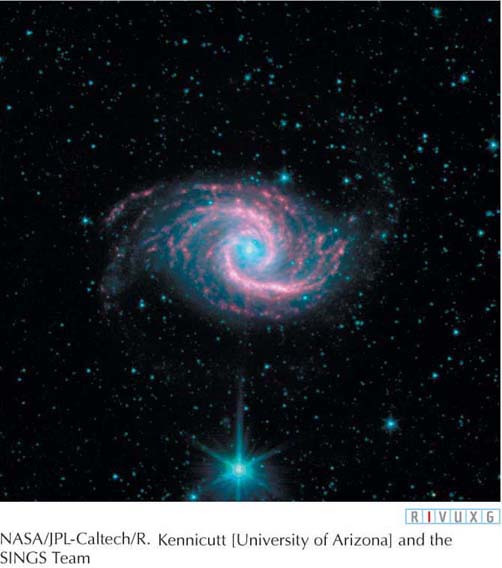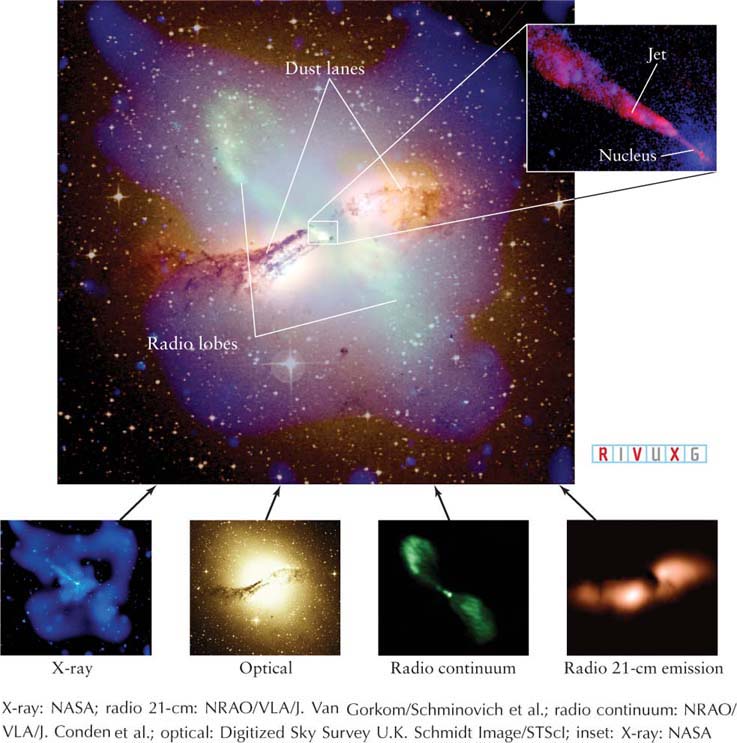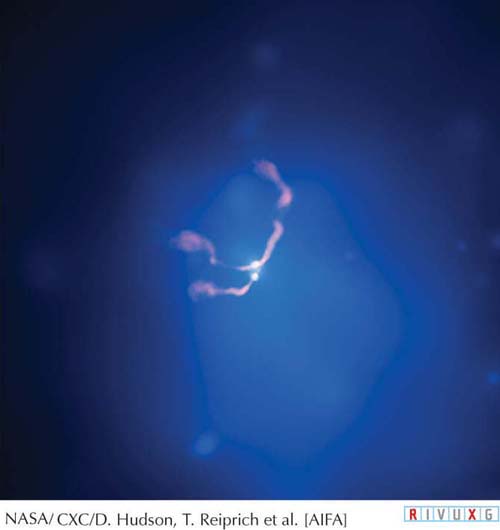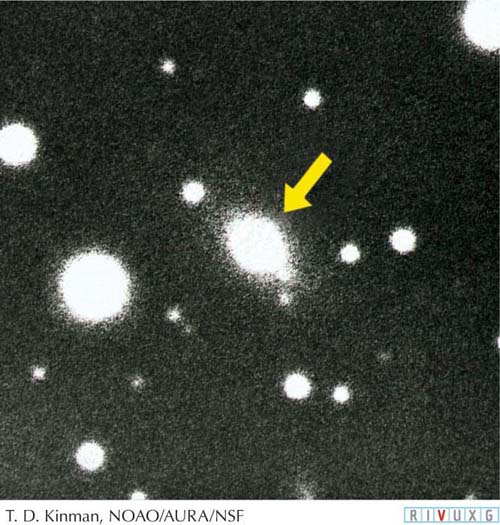OTHER ACTIVE GALAXIES
Quasars are but one kind of very powerful energy source in space. The others include Seyfert galaxies, radio galaxies, double-radio sources, and BL Lacertae objects. Located at the centers of galaxies, these powerhouses are collectively called active galactic nuclei, or AGN. The galaxies that contain AGN are called active galaxies. Active galaxies have unusually bright, starlike (that is, a pinpoint as seen from Earth) nuclei; their spectra do not look anything like a star’s blackbody spectrum; they have strong emission lines; many are highly variable, meaning that their brightness levels change in different parts of the electromagnetic spectrum; they have jets of electrons and protons and beams of radiation emanating from their cores like the emissions observed for 3C 273; and most are more luminous than ordinary galaxies.
13-20 Active galaxies can be either spiral or elliptical
Seyfert galaxiesCarl Seyfert at the Mount Wilson Observatory in California discovered the first active galaxies in 1943 among the spiral galaxies he was surveying. Now called Seyfert galaxies, these spirals reveal exceptionally bright, starlike nuclei and strong emission lines in their spectra. For example, the rich spectrum of NGC 4151 has many prominent emission lines. Some of these lines are produced by iron atoms with a dozen or more electrons stripped away, indicating that NGC 4151 contains some extremely hot gas. Individual Seyfert galaxies also fluctuate in brightness. For example, at times the magnitude of NGC 4151 changes perceptibly over the course of a few days.
Another example of a Seyfert galaxy is NGC 1566 (Figure 13-60). At infrared wavelengths, this galaxy shines with the brilliance of 1011 Suns. This extraordinary luminosity has been observed to vary by as much as 7 × 109 L⊙ over only a few weeks. In other words, the infrared power output of the nucleus of NGC 1566 increases and decreases by an amount nearly equal to the total luminosity of our entire Galaxy.

Figure 13-60  Seyfert Galaxy NGC 1566 This Sc galaxy is a Seyfert galaxy some 50 Mly (16 Mpc) from Earth in the southern constellation Dorado (the Goldfish). The nucleus of this galaxy is a strong source of radiation whose spectrum shows emission lines of highly ionized atoms.
Seyfert Galaxy NGC 1566 This Sc galaxy is a Seyfert galaxy some 50 Mly (16 Mpc) from Earth in the southern constellation Dorado (the Goldfish). The nucleus of this galaxy is a strong source of radiation whose spectrum shows emission lines of highly ionized atoms.
Many more Seyfert galaxies have been discovered in recent years. Approximately 10% of the most luminous galaxies in the sky are Seyferts. Some of the brightest Seyfert galaxies shine as brightly as faint quasars, with point sources in their centers. These are labeled Type 1 Seyferts. Seyfert galaxies whose centers are obscured by large amounts of gas and dust are Type 2 Seyferts.
Radio galaxiesSome elliptical galaxies, called radio galaxies because of their strong radio emission, are like lower-energy quasars. Although their energy source is very small, like that of a quasar, the resulting radio emissions of these active galaxies are spread over very large areas, often hundreds of thousands of light-years across.
Some radio galaxies are accompanied by unusual optical features; namely, the galaxies look as though they are exploding, which they are not. Such galaxies are therefore called peculiar galaxies (denoted pec). Peculiar is not the classification of a galaxy shape, like spiral, barred spiral, or elliptical. Any of the Hubble classes of galaxies (see Sections 13-8 through 13-12) can be peculiar.
Figure 13-61 is a combined X-ray, optical, and radio image of the peculiar elliptical galaxy NGC 5128 (Centaurus A) in the southern constellation of Centaurus. The dark region that cuts the elliptical galaxy in two is actually a region of very thick dust through which little light from the galaxy behind it can penetrate. The galaxy is ejecting large volumes of hot X-ray–emitting gas, as well as jets of gas in two radio lobes shown in this figure. NGC 5128 is classified as an E0 (pec). The E0 denotes a circular elliptical galaxy, while (pec) means that this galaxy has the features of a peculiar galaxy.

Figure 13-61  Peculiar Galaxy NGC 5128 (Centaurus A) This extraordinary radio galaxy is located in the constellation Centaurus, 11 million light-years from Earth. At visible wavelengths a dust lane crosses the face of the galaxy. Superimposed on this visible image is a false-color radio image (green) showing that vast quantities of radio radiation pour from matter ejected from the galaxy perpendicular to the dust lane, along with radio emission (rose-colored) along the dust lane, and X-ray emission (blue) detected by NASA’s Chandra X-ray Observatory. The X-rays may be from material ejected by the black hole or from the collision of Centaurus A with a smaller galaxy. Inset: This X-ray image from the Einstein Observatory shows that NGC 5128 has a bright X-ray nucleus. An X-ray jet protrudes from the nucleus along a direction perpendicular to the galaxy’s dust lane.
Peculiar Galaxy NGC 5128 (Centaurus A) This extraordinary radio galaxy is located in the constellation Centaurus, 11 million light-years from Earth. At visible wavelengths a dust lane crosses the face of the galaxy. Superimposed on this visible image is a false-color radio image (green) showing that vast quantities of radio radiation pour from matter ejected from the galaxy perpendicular to the dust lane, along with radio emission (rose-colored) along the dust lane, and X-ray emission (blue) detected by NASA’s Chandra X-ray Observatory. The X-rays may be from material ejected by the black hole or from the collision of Centaurus A with a smaller galaxy. Inset: This X-ray image from the Einstein Observatory shows that NGC 5128 has a bright X-ray nucleus. An X-ray jet protrudes from the nucleus along a direction perpendicular to the galaxy’s dust lane.
Detailed observations of Centaurus A reveal that both its radio and X-ray jets (see Figure 13-61 inset) originate in the galaxy’s nucleus. Particles and energy stream out of the galaxy’s nucleus toward the radio lobes at nearly the speed of light. Such galaxies, with two radio lobes, are now called double-radio sources. By 1970, radio astronomers had discovered dozens of other double-radio sources, usually in giant elliptical galaxies. Double-radio sources are among the brightest radio objects in the universe.
Focus Question 13-19
Is the Milky Way a peculiar galaxy? Why or why not?
All double-radio sources appear to have a central engine that ejects electrons, protons, and magnetic fields outward along two oppositely directed jets. After traveling many thousands or even millions of light-years, this material slows down, allowing charged particles and magnetic fields to produce the radio radiation that we detect. This type of radio emission, called synchrotron radiation (see Section 13-4), occurs whenever energetic electrons, protons, or ions move in a spiral path within a magnetic field.
The idea that a double-radio source emits jets of particles is supported by the existence of head-tail sources, so named because each such source appears to have a region of concentrated radio emission (the head) with two tails of gas that stream from it in opposite directions and then sweep back. NGC 1265, an active elliptical galaxy in the Perseus cluster of galaxies, shows these properties. NGC 1265 is known to be moving at a high speed (2500 km/s) relative to the Perseus cluster as a whole. In a radio map (Figure 13-62), its emission has a distinctly windswept appearance.
Protons and electrons ejected in the two jets from NGC 1265 are deflected by the galaxy’s passage through the sparse intergalactic medium. The head-tail source leaves behind a trail of particles, like the trail of smoke that pours from a rapidly moving steam train.
The giant elliptical galaxy M87 is a relatively weak radio galaxy, emitting only 1% as much energy as the Milky Way. Conversely, the distant, peculiar, elliptical galaxy Cygnus A (see Figure 13-53) is a powerful radio galaxy that emits 40 times as much energy as does our Galaxy. Pairs of orbiting supermassive black holes and accompanying double-radio sources have also been observed, such as 3C 75 (Figure 13-63). Table 13-2 summarizes the relative power emitted by the Sun, the Milky Way Galaxy, Seyfert galaxies, radio galaxies, and quasars.

Figure 13-63 
 Binary Head-Tail Source This combined radio and X-ray image of 3C 75 shows the head-tail sources emanating from supermassive black holes in a pair of galaxies that are in the process of merging. The black holes are separated by 25,000 ly and are 300 million ly away from Earth.
Binary Head-Tail Source This combined radio and X-ray image of 3C 75 shows the head-tail sources emanating from supermassive black holes in a pair of galaxies that are in the process of merging. The black holes are separated by 25,000 ly and are 300 million ly away from Earth.

Figure 13-62  Head-Tail Source NGC 1265 This active elliptical galaxy is moving at a high speed through the intergalactic medium. Because of this motion, the two tail jets trail the galaxy at its head, giving this radio source a distinctly windswept appearance.
Head-Tail Source NGC 1265 This active elliptical galaxy is moving at a high speed through the intergalactic medium. Because of this motion, the two tail jets trail the galaxy at its head, giving this radio source a distinctly windswept appearance.
TABLE 13-2
GALAXY AND QUASAR LUMINOSITIES

Figure 13-64  BL Lacertae This photograph shows fuzz around BL Lacertae (arrow). The redshift of this fuzz indicates that BL Lacertae is about 900 Mly (280 Mpc) from Earth. BL Lac objects appear to be giant elliptical galaxies with bright quasarlike nuclei, much as Seyfert galaxies are spiral galaxies with quasarlike nuclei. BL Lac objects contain much less gas and dust than do Seyfert galaxies.
BL Lacertae This photograph shows fuzz around BL Lacertae (arrow). The redshift of this fuzz indicates that BL Lacertae is about 900 Mly (280 Mpc) from Earth. BL Lac objects appear to be giant elliptical galaxies with bright quasarlike nuclei, much as Seyfert galaxies are spiral galaxies with quasarlike nuclei. BL Lac objects contain much less gas and dust than do Seyfert galaxies.
BL Lacertae objects and blazarsAlthough radio galaxies emit less energy from their nuclei than do quasars, there are also objects of the same size that from our vantage point emit even more energy than quasars. These are the BL Lacertae objects. The name comes from their prototype, BL Lacertae (also called BL Lac) in the constellation Lacerta (the Lizard). BL Lac (Figure 13-64) was discovered in 1929, when it was mistaken for a variable star, largely because its brightness varies by a factor of 15 in only a few months. A BL Lac’s most intriguing characteristic is an unusually weak set of spectral lines. In other words, its spectrum is not as easily identified as those of stars or interstellar clouds. Nevertheless, the spectra enable astronomers to determine the redshifts of these objects.
BL Lac objects are believed to be elliptical galaxies with bright quasars at their centers, much as Seyfert galaxies are spiral galaxies with quasarlike centers. BL Lac objects change intensities—they are variable. Those that have periods of a day or less are also called blazars. In 2004, a blazar with 10 billion solar masses located 12.5 Bly away was discovered. It is intriguing that this incredibly massive object formed only a billion years after the universe formed.





 Seyfert Galaxy NGC 1566 This Sc galaxy is a Seyfert galaxy some 50 Mly (16 Mpc) from Earth in the southern constellation Dorado (the Goldfish). The nucleus of this galaxy is a strong source of radiation whose spectrum shows emission lines of highly ionized atoms.
Seyfert Galaxy NGC 1566 This Sc galaxy is a Seyfert galaxy some 50 Mly (16 Mpc) from Earth in the southern constellation Dorado (the Goldfish). The nucleus of this galaxy is a strong source of radiation whose spectrum shows emission lines of highly ionized atoms. Peculiar Galaxy NGC 5128 (Centaurus A) This extraordinary radio galaxy is located in the constellation Centaurus, 11 million ligh
Peculiar Galaxy NGC 5128 (Centaurus A) This extraordinary radio galaxy is located in the constellation Centaurus, 11 million ligh
 Binary Hea
Binary Hea BL Lacertae This photograph shows fuzz around BL Lacertae (arrow). The redshift of this fuzz indicates that BL Lacertae is about 900 Mly (280 Mpc) from Earth. BL Lac objects appear to be giant elliptical galaxies with bright quasarlike nuclei, much as Seyfert galaxies are spiral galaxies with quasarlike nuclei. BL Lac objects contain much less gas and dust than do Seyfert galaxies.
BL Lacertae This photograph shows fuzz around BL Lacertae (arrow). The redshift of this fuzz indicates that BL Lacertae is about 900 Mly (280 Mpc) from Earth. BL Lac objects appear to be giant elliptical galaxies with bright quasarlike nuclei, much as Seyfert galaxies are spiral galaxies with quasarlike nuclei. BL Lac objects contain much less gas and dust than do Seyfert galaxies.